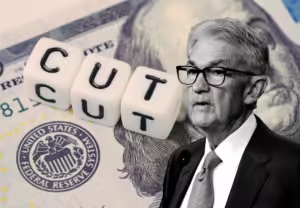With its first interest rate drop in four years, the US makes a major splash.

With a larger-than-normal drop, the US central bank has lowered interest rates for the first time in over four years.
The Federal Reserve lowered its benchmark lending rate objective by 0.5 percentage points, bringing it down to between 4.75% and 5%.
As price increases slow and worries about the job market increase, the bank’s head, Jerome Powell, said the move was “strong” but necessary. The bold action on Wednesday, according to Federal Reserve chair Jerome Powell, was meant to ensure that high borrowing costs, which were implemented to combat inflation, would not have a negative impact on the US economy.
Beginning in 2022, the Fed hiked interest rates significantly to stabilize prices, which were then rising at the quickest rate since the 1980s, and calm the economy.
Reducing spending was the goal of the actions, which had the unintended consequence of making mortgages, auto loans, and other debt more costly. As hiring stalled, the US unemployment rate increased from 3.7% at the beginning of the year to 4.2%. According to the latest Commerce Department data, the US economy expanded at a 3% annual rate in the three months leading up to June. Additionally, retail spending has held up well.
For the fifth consecutive month, inflation fell to 2.5% in August, bringing it closer to the Fed’s 2% target in a row.
“It’s a huge deal.”
Owner Jennifer Heasley of Sweet Mama’s Mambo Sauce in Pennsylvania, who used credit cards to help finance the growth of her barbecue-style sauce company two years ago, said she had been waiting impatiently for the Fed to take action. Following the first news, the Nasdaq, S&P 500, and Dow Jones Industrial Average all saw significant increases, although they ended the day slightly lower.
How will I be affected if the US lowers interest rates?

On Wednesday, the US central bank cut interest rates for the first time in four years.
Millions of people in the US and even outside will be impacted by the much-awaited action in terms of mortgages, credit cards, and savings rates.
The Federal Reserve lowered the main lending rate to a range of 4.75% to 5%, a reduction of half a percentage point.
What effects would a cut have on auto loans, mortgages, and other debt?
What businesses charge Americans for loans, such as mortgages, or other debt, such as outstanding credit card bills, is determined by the Fed’s key lending rate, or what it costs banks to borrow.
After rising from almost zero at the beginning of 2022, that rate has been at its highest level since 2001, circling at 5.3% for more than a year.
Borrowers will be somewhat relieved by a drop, but some banks will probably lower the rates they are giving savers as well.
US mortgage rates have already somewhat decreased, in part because of the shift.
What would the effects be on a global scale?
A change will most immediately impact Americans. However, borrowers in those nations will also be impacted because central banks with dollar-denominated currencies, including Hong Kong and numerous Gulf states, frequently connect their rate decisions to the Fed.
The Fed lowered rates, but why?

When it comes to rate-cutting, the Fed is a little late.
Rates have already been lowered in Europe, the UK, New Zealand, and Canada, as well as by other banks in emerging nations.
Regarding the Fed, it responds to two factors—inflation and employment—by lowering or raising interest rates. In the past, a string of rate hikes has frequently caused the US economy to enter a recession, costing millions of Americans their jobs.
Additionally, the US has seen a slight increase in unemployment over the past year due to a dramatic slowdown in hiring. For the past two years, both Republicans and Democrats have been closely observing this Fed’s actions, and a cut will probably benefit Democrats as the ruling party.
Was it unexpected that they cut by 0.5 percentage points?
Analysts disagreed ahead of the meeting on whether the Fed would announce a 0.25 percentage point drop or opt for a larger and more rare 0.5 percentage point cut.
A 0.25 percentage point cut was not made, despite what most people thought was likely. It was an extraordinarily high degree of uncertainty for a bank that has made a concerted effort to communicate its intentions far in advance.
